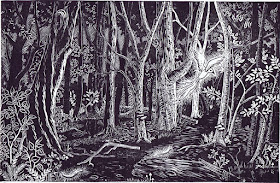For anyone with a taste for linguistics, it’s easy to see that grammar is glamorous, but not everyone may realize that these words are not only connected, but connected in their magical power. Let’s start with grammar. From Latin, from Greek, this word originally comes from the word for the art of letters, or writing. You can see the same root in telegram and hologram, as well as its alternate form in autograph, cryptography, calligraphy, and many more. In English the word grammar referred only to Latin grammar until the sixteenth century, except that originally it also referred to all sorts of knowledge, especially occult knowledge and magic. After all, those same Latin scholars often studied the protosciences such as alchemy and astrology. Even without that, the connection between writing and magic is long and deep. To those of us who take reading and writing for granted, writing may not seem anything out of the ordinary, but as Svarnil reminds Jiriya in Sleeping Legends Lie, writing is magic to those who cannot do it, and for most of history, that was most people. Writing, a powerful ability wielded by an elite few, has been considered to be magic in many cultures.
An early fourteenth century variant of grammar, gramary or gramarye, was revived by Sir Walter Scott in its meaning of “magical arts”, and Scott (1771-1832) is also responsible for the introduction of glamour to mainstream English. Glamour was a Scottish dialectal word, a variant of the archaic gramary, and it meant “a spell or enchantment, especially an illusion.” It was most common in the phrase “to cast a glamour.” The meaning “magical beauty, alluring charm” dates back to 1840. After all, making something more attractive has to be one of the most popular uses of magic and illusion.
A grammar can also be the book that lays out the rules of a language, and naturally when grammar could mean “occult knowledge”, seventeenth century French developed the word into grimoire, a textbook of magic or a book of spells. English borrowed this word in 1849.
Nowadays you’re unlikely to run into the word grimoire, or the magical meanings of gramarye and glamour, unless you’re reading fantasy. Nevertheless, it’s always wise to remember that there is a glamour to grammar. Language does indeed have the power to perform magic: everything from casting illusions both good or evil, to changing the very substance of the world.
[Pictures: wood block print from The Owl’s Almanac by Thomas Middleton, 1618 (Image from Morbid Anatomy);
Pentacles from The Key of Solomon, 1889 edition of a text dating to the Renaissance (Image from Internet Archive).]






















